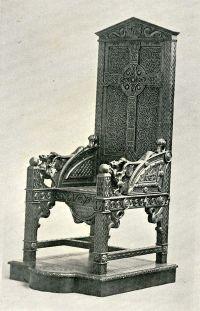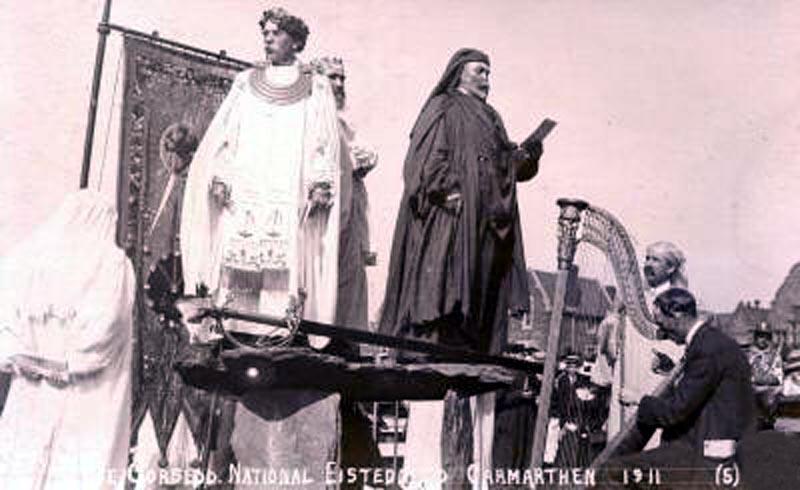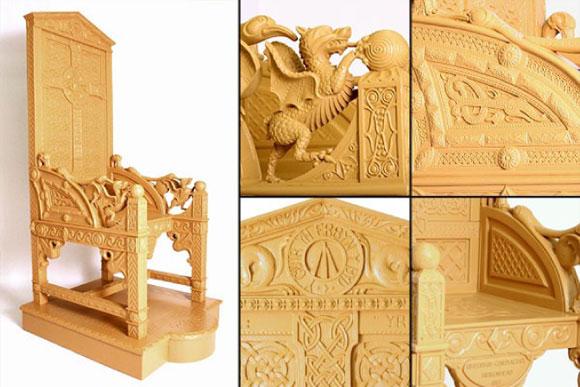Drumlord’s 3D Printed “Black Chair” Blends Modern and Traditional Building to Replicate Historical Bardic Chair
 3D printing’s intricate design potential has been realized in many artistic designs and projects already too numerous to count. I personally love any detail, craftsmanship, and design that announces that patience, time, and forethought have gone into a piece. In many ways this design style is the opposite of the streamlined, functional look popularized by mass produced furniture entities like IKEA. Paradoxically, it is precisely advances in technology and industry that may allow for a return to more traditional, antique, intricate design patterns today.
3D printing’s intricate design potential has been realized in many artistic designs and projects already too numerous to count. I personally love any detail, craftsmanship, and design that announces that patience, time, and forethought have gone into a piece. In many ways this design style is the opposite of the streamlined, functional look popularized by mass produced furniture entities like IKEA. Paradoxically, it is precisely advances in technology and industry that may allow for a return to more traditional, antique, intricate design patterns today.
Drumlord Limited‘s life-size 3D printed replica of the Welsh’s famous Bardic Chair ‘Y Gadair Ddu’ (The Black Chair) is the perfect example of such a combination of the new and the traditional — facilitated by 3D printing technology. The Welsh Government commissioned Drumlord to replicate The Black Chair to commemorate the centenary of World War I’s beginning in 1914. The finished chair, in fact, will be traveling throughout the UK and Europe as part of upcoming WWI centenary commemorations.
The story behind the chair is rather moving. The Welsh tradition of “chairing a bard” dates back to the medieval era, when a performance, poetry, and music festival named “Eisteddfod” began. During this event, which continues today, one poet would be selected as the winner of a chair after submitting a certain style of poem. In 1917, “The Bardic Chair” was awarded posthumously to Ellis Humphrey Evans (Hedd Wynn, Welsh for “blessed peace”), a Welsh poet, who had already received several chairs, but unfortunately died in combat six weeks before the ceremony. During the award ceremony that year, the poet’s chair was draped with a black cloth to honor Wynn, and it was henceforth known as “The Black Chair.” Eugeen Vanfleteren, a Belgian carpenter living in the UK, carved the original Black Chair, which was intended to be presented at the 1917 National Eisteddfod at Birkenhead Park.
Drumlord, along with Cardiff University, has done an incredible job replicating the Black Chair that symbolizes an important piece of Welsh literary, cultural, and military history. It used a combination of SLS and traditional model making for manufacturing the chair. From a digital scan of the original chair, Cardiff University developed a 3D CAD file that could be built as a series of SLS models. Then the chair was divided into sections for printing via SLS — ensuring the minimum disruption to the chair’s intricately carved patterns and features while also guaranteeing ease of assembly.
Once 3D printed, the team assessed the new chair for accuracy and straightened out signs of warping by using specially manufactured jigs to heat parts. Parts were then braced during the cooling process to return accurate shape. A ‘threaded bar and bolt’ structure drilled into chair sections allowed secure assembly of each part, as well as stability. This hidden ‘steel skeleton’ allowed the 3D printed sections to join together to get the solid look of the finished chair. For misaligned chair patterns, the craftsmen used traditional model making techniques to fill and blend jointed areas for continuity in the carving’s intricate patterns. The finishing touch was a primed and spray painted color.
You can see how well crafted the final product is — essentially flawless, in fact. As it travels Europe to commemorate World War I’s centenary, The Black Chair will serve as an educational piece on several fronts. It will teach about the Welsh Eideddfod tradition of “chairing a bard,” the biography of a famous Welsh poet, Hedd Wynn, and it will also display 3D printing potential to help recreate historic art and design pieces. Drumlord rather poetically summarized what the project meant to them:
This project allowed us to show how the very latest technologies can be combined with already well established, traditional techniques to deliver top quality models. The original
chair is very much a part of the cultural history of Wales and the reproduction is a reverential acknowledgment of a rich and important past while also looking firmly at the future.
After the chair’s tour ends, it will be displayed in St. Fagans National History Museum in Cardiff, where a little bit of 3D printing history will be on display, too. Let us know your thoughts on this project, and whether you see the 3D printed chair, over at the Black Chair forum thread at 3DPB.com.
Subscribe to Our Email Newsletter
Stay up-to-date on all the latest news from the 3D printing industry and receive information and offers from third party vendors.
You May Also Like
3D Printing Unpeeled: New Arkema Material for HP, Saddle and Macro MEMS
A new Arkema material for MJF is said to reduce costs per part by up to 25% and have an 85% reusability ratio. HP 3D HR PA 12 S has been...
3D Printing News Briefs, January 20, 2024: FDM, LPBF, Underwater 3D Printer, Racing, & More
We’re starting off with a process certification in today’s 3D Printing News Briefs, and then moving on to research about solute trapping, laser powder bed fusion, and then moving on...
3D Printing Webinar and Event Roundup: December 3, 2023
We’ve got plenty of events and webinars coming up for you this week! Quickparts is having a Manufacturing Roadshow, America Makes is holding a Member Town Hall, Stratafest makes two...
Formnext 2023 Day Three: Slam Dunk
I’m high—high on trade show. I’ve met numerous new faces and reconnected with old friends, creating an absolutely wonderful atmosphere. The excitement is palpable over several emerging developments. The high...


































